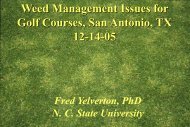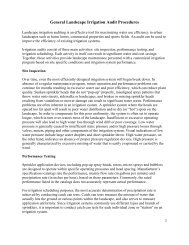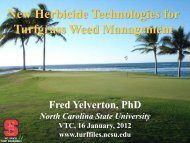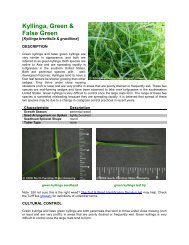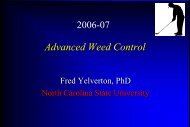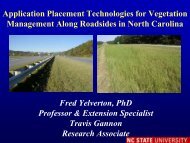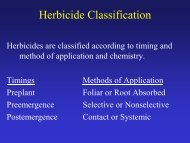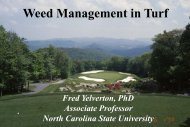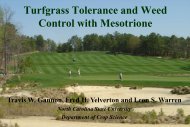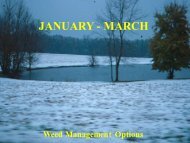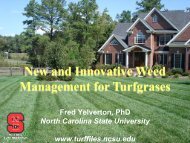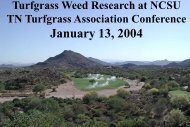Carolina Athletic Fields: - TurfFiles - North Carolina State University
Carolina Athletic Fields: - TurfFiles - North Carolina State University
Carolina Athletic Fields: - TurfFiles - North Carolina State University
- No tags were found...
You also want an ePaper? Increase the reach of your titles
YUMPU automatically turns print PDFs into web optimized ePapers that Google loves.
sium needed by your established field. Proper fertilizerrates and timing are essential for wear resistance, quickturfgrass recovery from traffic damage, and for aestheticconsiderations. A complete fertilizer with an N-P-K ratioof 4:1:2 or 4:1:3 can be used in lieu of a soil test, but it is apoor substitute. Determine the amount of fertilizer, ratioof nutrients or fertilizer elements, and time of applicationbased on the grasses being grown.A total of 5 to 7 pounds of nitrogen per 1,000 sq. ft.per year is generally required for bermudagrass turfgrassused for sports purposes. A general quick-release, lesscostly nitrogen source such as ammonium nitrate (33-0-0)or ammonium sulfate (21-0-0) can be used during normalsummer fertilization to promote rapid growth and colorresponse. Do not apply fertilizer to wet, dormant, or semidormantturf. This may cause leaf scorching and encouragenutrient leaching and weed infestation. Fertilizationapplication frequency is dependent on the nitrogen source.Quick release nitrogen sources are applied more frequentlyat lower rates than slow-release nitrogen sources.Many of the soils in <strong>North</strong> <strong>Carolina</strong> are acidic andwill require the application of lime to provide a goodgrowing medium. Soil pH should be between 6.5 and 7.0for optimum nutrient availability. Lime may be put onany time during the year. Fertilizers and lime should beapplied uniformly with a centrifugal (rotary) or droptypespreader. Apply half the fertilizer in one directionand the other half moving at right angles to the first passto ensure uniform coverage.Coring (Aerification)Soils that are subject to heavy traffic are prone to compaction.Soil compaction is especially prevalent along playerbenches, between hash marks, along sidelines, and in frontof goals, where traffic is very heavy. Coring (removing asoil core ¾- to 1-inch in diameter to a depth of 3 to 4 inches)will alleviate this condition. Core cultivation is one ofthe most important management practices for competitiveplaying fields, yet one of the least appreciated or implemented.Use a device that removes soil cores. Chop up thecores and, if possible, distribute them by dragging with aspan of chain-link fence or a mat. Core when the turfgrassis actively growing so that it can recover from any injury.<strong>Fields</strong> should be cored a minimum of twice yearly, oncein the spring (April or May), just before fertilization, andagain in mid to late summer. For fields that see intensivepractice and play, will be overseeded, or are constructedwith a heavy soil profile, plan to core a minimum of 3 to4 times per growing season. Begin in late April or earlyMay and repeat monthly, or at least every other month,until cool fall temperatures halt bermudagrass growth orone month before anticipated fall overseeding time. Somelawn care and landscape companies offer coring service ifequipment is not available on site.Regular aerification of fields is one of the most importantmanagement practices for maintaining quality sports fields.VerticuttingBermudagrass tends to build up thatch when it is heavilyfertilized and watered. When thatch exceeds 0.75 inch,the field should be verticut and cored. When not excessive,thatch buildup can be removed from warm-seasongrasses by cutting as closely as possible at spring greenupand then raking by hand. If the field is heavily worn,verticutting may not be necessary, or necessary only inless-used areas of the field. Some lawn care and landscapecompanies have specialized equipment and offer powerraking services.TopdressingTopdressing is a maintenance practice that helps controlthatch and level (or smooth) out low spots or ruts inthe playing surface. Topdressing (if affordable) shouldbegin in early spring immediately following core aerification,vertical mowing, and fertilization. Routinetopdressing rates may be up to ¼ inch in depth perapplication (approximately 34 cubic yards per acre).Topdress with soil similar to the playing field profileto prevent the formation of layers. Use a pull behindsteel dragmat or brushes to incorporate the topdressingmaterial into the turfgrass.OVERSEEDINGOverseeding sports fields in fall with ryegrass serves twomain purposes: (a) provides desirable green color duringfall, winter, and early spring months for spectators and,(b) helps protect the bermudagrass from excessive wearduring cooler months when it is not actively growing.Overseeding, however, is an expensive, time-consumingoperation. Overseeded grasses are also very competitive11



